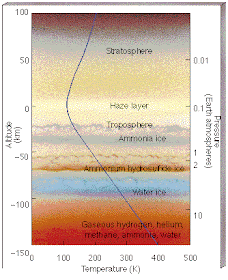Jupiter, and the other giant planets of our solar system, trap water in their tropospheres. Any water vapor rising in the troposphere will condense out at a set point in the atmospheric layer, forming clouds and eventually falling as rain. Exactly how much and how high this happens will vary, depending on how warm the planet is (cold Neptune probably doesn't have to much water vapor to start with), but no (or very, very little) water should be able to escape the troposphere into the overlying stratosphere. Yet the Infrared Space Observatory and the Spitzer Space Telescope have been able to detect water in the stratospheres of all the giant planets, leaving scientists to speculate as to how it got there.

The atmosphere of Jupiter; water condenses out far below the bottom of the stratosphere.
In the absence of a theoretical model that can explain how water might rise into the Jovian stratosphere from bellow, planetary scientists assume that it must come from above arriving from space into the top of the atmosphere and working its way downwards through the layers of the Jovian atmosphere. In 1994 the comet Shoemaker-Levy 9 gave a good demonstration of one way in which this could happen, as it passed close to the giant planet, was torn apart by it's gravity, and finally plunged into the Jovian atmosphere in a series of impacts. But not everyone was completely convinced by this Shoemaker-Levy 9, like most comets, is thought to have been composed largely of water-ice, and certainly entered the Jovian atmosphere from above, but it was traveling at quite a speed, and so not much of it may have stayed in the upper atmosphere. Some scientists favor a different model for the arrival of water in the Jovian atmosphere, suggesting that of occasional big inputs of water, Jupiter may instead receive a steady flow of frozen space dust, from the trails of comets that have crossed its path (which would be a lot more abundant at Jupiter's orbit than it is at Earth's).
In a forthcoming paper in the journal Planetary and Space Science, a team lead by Thibault Cavalié of the Max Planck Institute for Solar System Research, the Observatoire Aquitain des Sciences de l'Univers at the Université de Bordeaux and the Laboratoire d'Astrophysique des Sciences de Bordeaux present the result of a six year study into the Jovian atmosphere using the Swedish Odin Space Telescope, from 2003-9, combined with earlier data from 1999-2002, giving a ten year dataset.

Artist's impression of Odin. From the University of Calgary.
In theory if the water in Jupiter's stratosphere was delivered by rare commit impacts then it would fall steadily over the period of the study, as the water delivered by Shoemaker-Levy 9 was lost to diffusion into the lower atmosphere and photodissociation into hydrogen and oxygen (in the upper atmosphere of planets - including Earth - molecules are easily split into their constituent atoms by solar radiation), eventually disappearing completely about 15 years after the impact. If Jupiter receives its water from frozen, icy, space-dust, then the level of water in the atmosphere should have remained more-or-less constant during the period of the study.
In the event the level of water did fall over the period of the study, at a rather faster rate than predicted by the model. This suggests that Jupiter does in fact get the water in it's stratosphere from cometary impacts, but that we still do not have a full understanding of the processes in the Jovian atmosphere.
Cavalié et al. also note that in July 2009 another object was seen to collide with Jupiter, though since this object was not observed before the collision, it is unclear whether it was a (stoney) asteroid or an (icy) comet. In theory it ought to be possible to deduce the nature of this object by studying the evolution of the Jovian stratosphere.

Hubble image of the Southern Hemisphere of Jupiter after the 2009 impact; the large black mark is the impact site. NASA/ESO.
See also New study of Europa's 'chaos terrains' reveals subsurface lakes, but not oceans and Jupiter on Sciency Thoughts YouTube.
